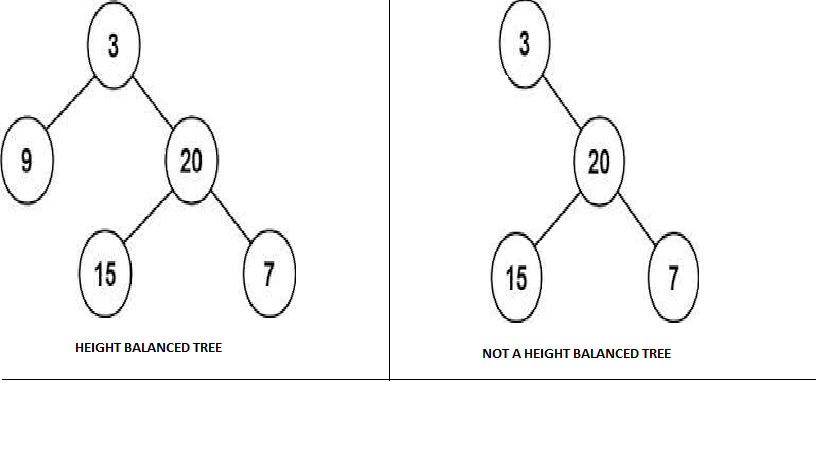Problem
Given a binary tree. You need to check if it is height-balanced or not. A tree is height-balanced if the absolute difference between the height of the left and right subtrees is not more than 1.
Sample Input

Sample Output
YES
Explanation
Each node’s left and right subtree difference does not exceed 1.
Approach
We can use DFS to solve this problem. We go to the depth of the tree (leaf nodes) and keep returning heights to the parent nodes. The height returned by a child to its parent would be 1 greater than the maximum height of this child. This way, we keep track of the height difference of each node’s subtrees. The child returns height to its parent when we backtrack. For instance, if the tree is
1
/ \
2 3
1 -> 2 -> NULL, NULL returns 0 2 -> NULL, NULL returns 0 (Now backtrack and return 1+max(2->left, 2->right)) 1 will now have height of its left subtree as 1 1 -> 3 -> NULL, NULL returns 0 3 -> NULL, NULL returns 0 (Now backtrack and return 1+max(3->left, 3->right)) 1 will now have height of its right subtree as 1 The absolute difference would be 1-1=0 which is height-balanced.
Complexity Analysis
The time complexity would be O(N), and the space complexity would also be O(N) due to the call stack.
C++ Programming
#include<bits/stdc++.h>
using namespace std;
struct TreeNode
{
int val;
TreeNode *left, *right;
TreeNode(int val)
{
this->val = val;
this->left = this->right = nullptr;
}
};
int dfs(TreeNode* root, bool &ok)
{
// if NULL node found
if (root == nullptr || !ok) {
return 0;
}
// get the height of the left subtree
int left = dfs(root->left, ok);
// get the height of the right subtree
int right = dfs(root->right, ok);
if (abs(left - right) > 1) {
ok = false;
}
// return height of subtree rooted at the current node
return max(left, right) + 1;
}
bool dfs(TreeNode* root)
{
bool ok = true;
dfs(root, ok);
return ok;
}
int main()
{
TreeNode* root = new TreeNode(1);
root->left = new TreeNode(2);
root->right = new TreeNode(3);
if (dfs(root)) {
cout << "Tree is balanced";
}
else {
cout << "Tree is not balanced";
}
return 0;
}
Output
Tree is balanced
Java Programming
import java.util.concurrent.atomic.AtomicBoolean;
class TreeNode
{
int val;
TreeNode left = null, right = null;
TreeNode(int val) {
this.val = val;
}
}
class Main
{
public static int dfs(TreeNode root, AtomicBoolean ok)
{
// if node is NULL
if (root == null || !ok.get()) {
return 0;
}
// left subtree height
int left = dfs(root.left, ok);
// right subtree height
int right = dfs(root.right, ok);
if (Math.abs(left - right) > 1) {
ok.set(false);
}
// return height of subtree rooted at the current node
return Math.max(left, right) + 1;
}
public static boolean dfs(TreeNode root)
{
AtomicBoolean ok = new AtomicBoolean(true);
dfs(root, ok);
return ok.get();
}
public static void main(String[] args)
{
TreeNode root = new TreeNode(1);
root.left = new TreeNode(2);
root.right = new TreeNode(3);
if (dfs(root)) {
System.out.print("Tree is balanced");
}
else {
System.out.print("Tree is not balanced");
}
}
}
Output
Tree is balanced
Python Programming
class TreeNode:
def __init__(self, val, left=None, right=None):
self.val = val
self.left = left
self.right = right
def dfs(root, ok=True):
# if node is NULL
if root is None or not ok:
return 0, ok
# get the height of the left subtree
left, ok = dfs(root.left, ok)
# get the height of the right subtree
right, ok = dfs(root.right, ok)
if abs(left - right) > 1:
ok = False
# return height too parent
return max(left, right) + 1, ok
root = TreeNode(1)
root.left = TreeNode(2)
root.right = TreeNode(3)
if dfs(root)[1]:
print("Tree is balanced")
else:
print("Tree is not balanced")
Output
Tree is balanced
People are also reading:
- Merge Two Sorted Arrays in-place
- Subarray with Sum k
- Longest Palindromic Subsequence using Dynamic Programming
- Maximum Sum Circular Subarray
- Find Maximum Subarray Sum
- Sort an array in one swap whose two elements are swapped
- Dutch National Flag Problem
- Construct a tree from Inorder and Level order traversals
- Rearrange an array such that arr[i] = i
- Minimum Edit Distance





Leave a Comment on this Post